Darla Blesz
Eldridge, Iowa
2020
Note: This project developed during fall 2020, when many schools were closed because of the COVID-19 pandemic and parents struggled to find ways to support and engage their children in academic work. Carson was 11 years old then. Although projects featured on IEL typically focus on early childhood, we are including Carson’s project because it illustrates the power of parent-supported, individual, child-led project work. The story is told by his mother with hope that it may inspire family-supported project work that can increase the engagement of a younger child.
Carson’s interest in fishing began during previous trips to his grandparents’ farm in southern Missouri, where opportunities to fish in rivers and lakes are readily available. His first-hand experiences using worms and minnows for bait, and the excitement of catching a fish with his grandfather and then frying it for dinner, provided a tangible basis for understanding the basics of fishing. His interest in fishing was revived over the summer while spending days at home during the COVID-19 quarantine. He also had moved to a new home where he had access to a neighborhood lake, had spent time helping his grandpa stock his newly constructed pond, and had fished on Stockton Lake from a pontoon boat.
Phase 1: Beginning the Project
The investigation began at the end of September when Carson watched fishing videos and read information from various online sources provided by the conservation department and fishing experts. In preparation for the project, I established an area at a workbench in the garage where project-related items, including a display rack for pictures, could be displayed, and I agreed with Carson that all notes would be stored in his personal notebook so he could access project-related materials at any time (see Figure 1).
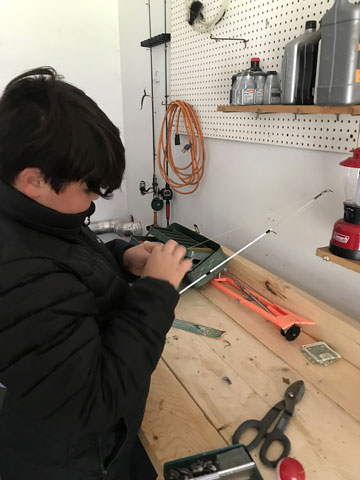
Based on our discussions, we kept an ongoing list of Carson’s questions about fishing:
- Which lures or bait catch bass, bluegill, or catfish?
- Are there giant carp in the lake?
- Where is the best place to catch fish?
- What types of fishing kayaks could I afford?
- Can I afford a boat for our lake?
- What kind of reel should I use?
- What other equipment (rod, pliers) do I need to catch fish?
- How do I go ice fishing in the winter?
- What kind of tools do I need for ice fishing, besides a pole?
- What kind of fish will I catch in the winter?
To answer Carson’s questions, we decided that we would need to test different types of equipment and seek the advice of experts such as our neighbor, Carson’s grandfather, and the employees at the local Field and Stream store.
Phase 2: Developing the Project
To support Carson’s interest and ability to investigate the topic, I provided Carson with a new toolbox, tools for adding line and tying lures, tools for removing a fish stuck on a hook, and lures for catching the types of fish found in our lake. I helped Carson find online video demonstrations, and I also gave him Conn Iggulden’s The Dangerous Book for Boys, which has a section on fishing.
We made two field trips to Field and Stream during the project. On the first trip, Carson bought a baitcaster-type rod and explored lures and bait. His research told him the baitcaster was the best rod for catching bass, which are prevalent in our neighborhood lake. While there, he used chore money to buy a set of bass fishing lures, spinners, clickbait, and rubber worms with tails.
On the second field trip, Carson had a few questions about fishing for catfish and bass ready for the salesman, who happened to be an experienced fisherman (see Figure 2). Questions included:
- Are there different poles for catching catfish? How are they different than other poles?
- What type of bait do bass like to bite?
- Where/when should I fish to catch a catfish?
- Do the catfish bite live bait, lures, or the smelly bait?
- How do I use the baitcaster reel and open-faced reel?
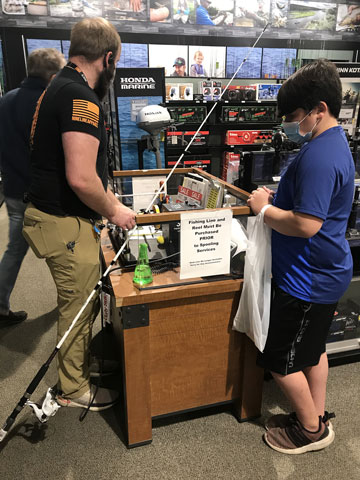
Carson explored the differences in poles, observing the pole for catching catfish was much sturdier and more flexible than his bass fishing pole. The salesman was able to direct him to the type of line and hook that was most likely to keep a catfish on the line. They discussed the idea of “stinky” bait (e.g., shrimp, raw chicken soaked in Kool-Aid) and factory-made catfish bites to attract the “big cat’s” attention. He also purchased the required rod and reel.
Fishing opportunities were usually after school or on the weekends and gave Carson chances to discover the tools he needed and experiment with how to plan and pack needed items. He sorted supplies into categorized compartments in his fishing toolbox and carried other supplies to the lake in a backpack. He learned to use loop or clinch knots to secure the hook and weights to the line. Neighbors with fishing experience provided information on using bait such as wax worms to catch bass.
I continued to collect Carson’s questions, and I used them to help Carson find ways to answer them. I used many “What do you think?” and “What can you try next?” questions to allow him to take the lead. He learned a lot about fishing by examining the situation and problem-solving. For example, trying to match the right lure/bait to the right fish led to many trial-and-error situations. He was able to make connections between characteristics of fish and differences in the type of bait or lures used, where fish hide, and what time of day or year fish bite. For example, he discovered that catfish have whiskers that allow them to hide in holes around rocks and docks without getting stuck and that catfish prefer food that lives in this habitat. He found that bass are not as picky and can be found in a variety of locations in the lake.
Being able to touch and examine the fish firsthand provided the opportunity for Carson to make connections between their anatomical features, their preferences, and their habitat. For example, he found that catfish have larger eyes that are spread further apart on the head and a wide oval mouth with whiskers. They are greyish green in our lake, but he discovered that river fish have a strong green tint in comparison. We learned to watch out for the “horns” (sharp fins behind the gills). Bass, in comparison, have a longer, narrow mouth and green and yellow patterns on their side scales (see Figure 3).
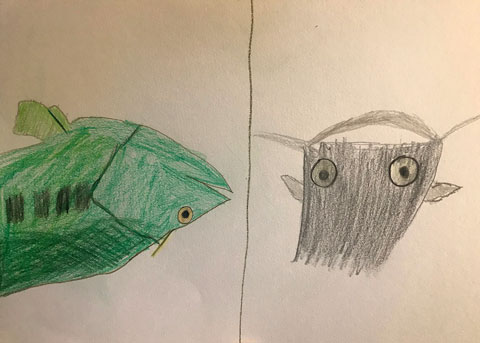
Carson discovered that he was most likely to find fish under a dock, under a boat, or near the rocky shore. Coves also were a likely hangout. He also saw grass carp and muskrats near the shoreline and in areas thick with cattails. We speculated about the large fins of the grass carp that stuck out just above the water line. Muskrats looking for an evening snack even stole a fish from Carson’s hook!
Catfish were the most difficult fish to catch in the lake. Carson’s first catfish catch was a surprise (see Figure 4). After catching this big one, he was determined to catch another, but several days passed without a catch. He persisted and realized that he had to adjust his equipment and strategies.
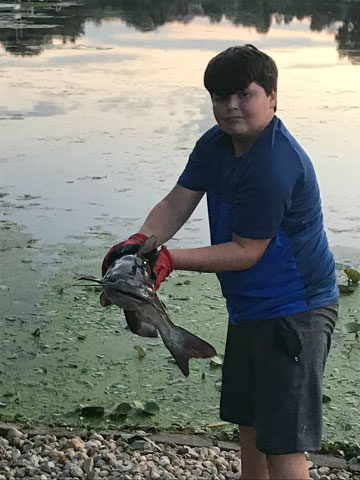
Carson left the ingredients for “stinky” shrimp out on the kitchen counter, and this was the key to catching another catfish. He discovered that catfish are more active on drizzly, rainy nights. He showed perseverance as we ventured out at his request on a dark rainy night, which led to his big catch.
While he was not drawn to using the clipboard, Carson did use pens, paper, and a camera to create representations related to his investigation. He drew a plan for how to lift the sinking end of a neighbor’s fishing dock and made models of the fish he drew (see Figure 5).
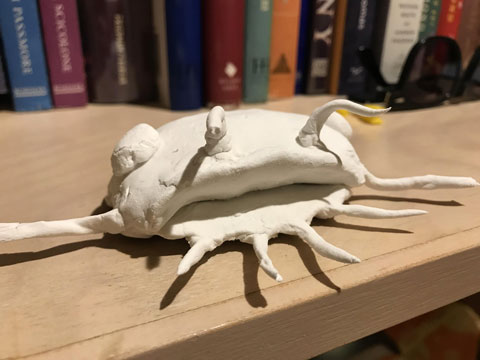
Phase 3: Concluding the Project
Carson’s final web reveals that he learned a lot about fish and fishing during this individual project (see Figure 6). He has been sharing what he knows about fishing with visitors to our home and online with his grandparents, and he plans to ice fish with an experienced neighbor using the ice fishing pole he bought at a rummage sale. He also plans to save money for a larger fishing-style kayak or small fishing boat to use in the warmer spring weather. His enthusiasm is catching, and we have begun to research potential family outings that will provide new fishing experiences.

Mother’s Reflection
Projects suitable for long-term investigation provide many avenues for children to ask questions and many possible ideas for them to explore. For Carson, one answered question led to another, perhaps because fishing is a very diverse topic with a plethora of learning opportunities in math, science, literacy, and nature. Over time Carson was able to gather information and make comparisons and connections with the evidence he found through hands-on exploration. These discoveries led to informed conclusions and deeper levels of learning, enhancing not only his ability to catch the desired fish but also self-confidence in his problem-solving ability. Carson will no doubt build upon what he has learned to approach more complicated fishing endeavors in the future. In addition, this project was fun for our family!

